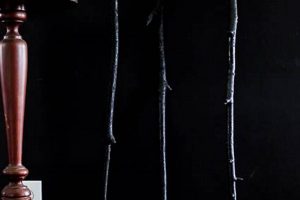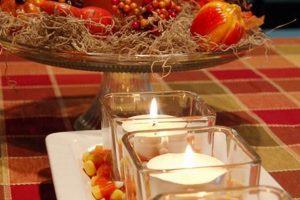Creating spectral figures and scenes at home, using readily available materials, to enhance seasonal aesthetics is a popular activity. These handcrafted apparitions can range from simple paper cutouts to more elaborate fabric constructions. For instance, draping white sheets over balloons and drawing faces transforms ordinary materials into eerie specters.
The appeal lies in the personalized nature of these creations, allowing individuals to express creativity and resourcefulness while saving costs compared to store-bought alternatives. Historically, the practice of crafting spooky decor connects to traditions surrounding Samhain and All Hallows’ Eve, representing both remembrance and warding off negative spirits. The activity fosters a sense of community and shared experience when undertaken in groups.
Subsequent sections will explore specific techniques for constructing these ethereal embodiments, examining materials, construction processes, and design considerations relevant to generating effective and visually striking seasonal displays. This includes insights into lighting techniques, fabric selection, and strategies for achieving various levels of atmospheric effect.
Crafting Ethereal Ambiance
The following guidance provides actionable steps to enhance the creation and deployment of seasonal, self-made spectral representations.
Tip 1: Material Selection. Prioritize lightweight, translucent materials such as cheesecloth, muslin, or even repurposed sheer curtains. These materials allow for effective backlighting and create a more convincing ethereal form.
Tip 2: Utilizing Illumination. Employ LED lights sparingly, focusing on warm white or pale blue hues. Avoid excessively bright or harsh lighting, which can detract from the spectral illusion. Consider battery-operated options for placement flexibility.
Tip 3: Strategic Placement. Position the apparitions in areas where they will benefit from ambient light sources, such as near windows or doorways. Avoid placing them in direct sunlight, as this diminishes the intended effect.
Tip 4: Proportional Scaling. Maintain proportional accuracy relative to the surrounding environment. Overly large or small representations can appear comical rather than unsettling. Consider the visual impact from various vantage points.
Tip 5: Secure Mounting. Employ discreet methods for securing the apparitions, such as fishing line or clear adhesive hooks. Ensure that the attachment points are stable and capable of withstanding moderate wind or accidental contact.
Tip 6: Incorporate Movement. Introducing subtle movement, either through internal fans or strategic positioning in natural air currents, can enhance the illusion of sentience and dynamism.
Tip 7: Weatherproofing Considerations. For outdoor placements, select weather-resistant materials or implement protective measures to prevent damage from rain, wind, or excessive sunlight exposure. Consider sealed battery compartments for lighting.
Effective execution of these techniques translates to compelling seasonal representations, capable of evoking the desired atmosphere with a blend of craftsmanship and strategic placement.
The ensuing section will provide concluding remarks and highlight the broader implications of this practice.
1. Material Translucency
Material translucency is a pivotal characteristic dictating the effectiveness of self-made spectral decor. It directly influences the play of light and shadow, contributing significantly to the illusion of an ethereal presence. Proper consideration of translucency levels is crucial for achieving the desired atmospheric effect.
- Light Diffusion
Translucent materials, such as cheesecloth or thin muslin, facilitate the scattering of light. This diffusion softens harsh light sources, creating a glow that approximates a spectral aura. Opaque materials, conversely, block light entirely, negating the desired effect. Choosing the correct material optimizes light distribution, resulting in a more believable apparition.
- Shadow Formation
The level of translucency impacts the nature of shadow formation. Semi-translucent materials cast diffuse shadows, blending seamlessly with the surrounding environment. This subtle shading enhances the three-dimensionality of the form without detracting from its ethereal qualities. Opaque materials create stark, defined shadows that undermine the illusion of a ghostly presence.
- Backlighting Capabilities
Translucent fabrics are conducive to backlighting techniques. Placing a light source behind the decoration allows the material to glow, accentuating its form and creating a striking visual effect. The level of translucency determines the intensity and evenness of the emitted light. Materials with limited translucency restrict the passage of light, resulting in uneven illumination and reduced impact.
- Atmospheric Depth
Layering multiple translucent materials of varying densities creates a sense of depth and complexity. This technique simulates the appearance of spectral layering, suggesting that the figure is not simply a flat surface but possesses internal volume and ethereal composition. The careful manipulation of translucent layers significantly enhances the overall atmospheric effect, creating a more immersive and convincing visual experience.
In conclusion, strategic selection and utilization of translucent materials are paramount in achieving a convincing and visually appealing spectral manifestation. By carefully considering light diffusion, shadow formation, backlighting capabilities, and atmospheric depth, creators can maximize the ethereal qualities of their seasonal decor, transforming simple materials into captivating visual elements. The interplay of light and material defines the success of any such endeavor.
2. Lighting Effects
The strategic application of illumination fundamentally shapes the perceived effectiveness of handcrafted spectral adornments. Lighting effects dictate the mood, visibility, and overall impact of these seasonal creations. A comprehensive understanding of lighting principles is therefore essential for successful implementation.
- Color Temperature and Spectral Atmosphere
Color temperature, measured in Kelvin, directly influences the atmosphere projected by the display. Warm white or amber lighting (2200K-2700K) can evoke a sense of age or unease, while cooler blue or green hues (4000K-6000K) contribute to a more overtly ghostly or chilling aesthetic. The selected color temperature should align with the desired emotional response from viewers. For example, projecting a pale blue light through cheesecloth emphasizes a colder, more detached representation.
- Light Intensity and Shadow Play
Light intensity affects the visibility and dimensionality of the representation. Subdued lighting allows shadows to deepen, creating a more mysterious or ominous presence. Excessive brightness, conversely, can wash out details and diminish the intended effect. The strategic placement of light sources, such as uplighting or backlighting, allows for the manipulation of shadow patterns, enhancing the three-dimensional appearance of the spectral form. Direct, harsh lighting often degrades the overall aesthetic.
- Dynamic Lighting and Movement Illusion
Employing dynamic lighting techniques, such as flickering LEDs or slowly pulsing illumination, can introduce a sense of movement and realism to the display. This effect is particularly effective when coupled with lightweight materials that respond to subtle air currents. The illusion of movement enhances the perception of sentience or ethereal presence, making the representation more engaging. Random, sporadic bursts of light and shadow mimic natural phenomena, adding a layer of believability.
- Light Projection and Surface Interaction
The manner in which light interacts with the surface of the chosen material is crucial. Translucent materials, such as cheesecloth or thin fabric, allow light to pass through and scatter, creating a soft, ethereal glow. Opaque materials, on the other hand, block light, resulting in stark shadows and a more defined form. Experimentation with various material-light combinations allows for the creation of unique and visually striking effects. Projecting patterns or textures onto the material further enhances its visual complexity and adds depth to the scene.
In summary, the considered application of lighting techniques elevates the effectiveness of these seasonal creations from simple crafts to compelling atmospheric installations. By thoughtfully manipulating color temperature, light intensity, dynamic effects, and surface interactions, individuals can craft immersive and visually captivating spectral representations that effectively evoke the desired mood and aesthetic. Effective lighting transforms a basic construction into a nuanced and unsettling visual.
3. Suspension Methods
Effective suspension is paramount to achieving the desired ethereal effect in self-constructed spectral representations. The method employed dictates the perceived weightlessness and positioning of the figure, significantly influencing its overall believability and atmospheric impact. The selection of an appropriate suspension strategy is therefore a critical component of the design process.
- Monofilament Line Application
Monofilament line, commonly known as fishing line, provides a near-invisible means of support. Its transparent nature minimizes visual distraction, creating the illusion that the decoration is floating independently. Different line weights should be considered based on the weight of the material being suspended. Improper weight assessment can lead to breakage or sagging, compromising the effect. Attachment points should be strategically placed to maintain balance and prevent unnatural tilting or rotation.
- Wireframe Construction and Support
For more complex or three-dimensional representations, a wireframe provides internal structure and support. Lightweight wire, such as aluminum or craft wire, can be shaped to define the contours of the figure. The wireframe is then suspended from above, providing a rigid and stable platform. This method is particularly useful for larger decorations or those incorporating multiple layers of material. The wireframe itself should be concealed within the fabric or material of the representation to maintain the illusion of ethereal form.
- Counterweight Balancing Systems
In certain configurations, a counterweight system can be employed to achieve dynamic balancing or controlled movement. A small weight is attached to the bottom of the representation, counteracting the upward pull of the suspension point. This system allows for subtle swaying or rotation in response to air currents, enhancing the illusion of a sentient presence. Careful calibration of the counterweight is essential to achieve the desired effect without introducing instability or abrupt movements.
- Adhesive Mounting Techniques
For smaller, lightweight representations, adhesive mounting provides a discreet alternative to traditional suspension methods. Clear adhesive hooks or strips can be attached to ceilings or walls, providing a secure attachment point. The adhesive must be appropriate for the surface material to prevent damage or detachment. This method is best suited for surfaces that are relatively smooth and clean. Careful placement is essential to ensure that the representation hangs evenly and maintains the desired orientation. The adhesive should be concealed as much as possible to minimize visual disruption.
The application of these suspension methods directly influences the perceived realism and atmospheric quality of these handmade spectral forms. Whether employing near-invisible monofilament, constructing internal wireframes, utilizing counterweight systems, or opting for adhesive mounting, the chosen technique must harmonize with the materials, scale, and intended effect of the decoration. An effectively suspended representation enhances the illusion of weightlessness and ethereal presence, transforming simple materials into captivating seasonal displays.
4. Facial Expressions
Facial expressions, when applied to spectral decor, significantly influence the viewer’s emotional response and interpretation of the crafted apparition. The inclusion, omission, or style of facial features directly determines whether the creation evokes fear, amusement, or a more ambiguous sentiment. The deliberate crafting of facial expressions serves as a crucial element in communicating the intended thematic message of the display. For example, simple black circles for eyes and a downturned mouth on a white sheet ghost immediately convey sadness or a haunting melancholy, differing sharply from jagged, sharp teeth which would convey a terrifying presence. The absence of a face might suggest anonymity, a more generalized symbol of death, or simply a lack of intention.
The execution of facial expressions can range from simplistic to highly detailed, depending on the desired level of realism and artistic skill. Simplified approaches, such as using felt cutouts or marker drawings, are suitable for younger audiences or for creating a more cartoonish aesthetic. More elaborate methods, involving sculpting clay features or employing advanced painting techniques, are appropriate for achieving a more lifelike or disturbing effect. The choice of medium directly impacts the final impression; a painted expression on cheesecloth will yield a very different aesthetic than a sculpted face adhered to a sturdier frame. One might consider researching historical interpretations of specters to guide design choices, ensuring the crafted face reflects established cultural associations with death and the afterlife.
Ultimately, the strategic implementation of facial expressions transforms a basic homemade specter into a potent symbol capable of communicating complex emotions and narratives. While some might choose to omit them entirely, the decision to include, or exclude, and how to stylize facial expressions, demands careful consideration of the desired impact and thematic goals. By understanding the nuanced role of facial expressions, creators can effectively manipulate the emotional response of their audience, maximizing the potency and overall success of their seasonal creations.
5. Fabric Drape
Fabric drape, in the context of creating handmade spectral figures, fundamentally influences the perceived form and realism of the decoration. The way a fabric falls, folds, and conforms to a supporting structure directly determines whether the specter appears ethereally fluid or rigidly artificial. Incorrect drape can undermine the intended illusion, regardless of other design elements. For example, a sheet of stiff canvas draped over a form creates a stark, unconvincing shape, whereas lightweight cheesecloth allowed to billow naturally simulates a more spectral presence. The specific qualities of the fabric and the intentional manipulation of its drape are therefore crucial to achieving the desired atmospheric effect. The texture can also impact drape. Satin, while visually appealing, can have a less realistic drape than muslin or cheesecloth.
The practical application of this understanding involves careful fabric selection and strategic shaping techniques. Lighter materials, such as cheesecloth, voile, or thin muslin, naturally drape with greater fluidity, lending themselves well to ghostly forms. These materials can be further manipulated through strategic wetting, weighting, or gathering to create specific shapes and folds. For instance, dampening the fabric before draping it over a form allows it to conform more closely, creating a more defined and less rigid silhouette. Alternatively, strategically placed weights can pull the fabric into graceful curves, simulating movement and ethereal flow. The drape may need to be secured with adhesive, creating a fixed fold to highlight an area. A fabric with some stiffness may need to be gathered and held in place to maintain its form.
In summary, effective fabric drape is an indispensable component in crafting persuasive spectral figures. The careful selection of materials based on their draping characteristics, coupled with deliberate shaping techniques, results in a more realistic and visually compelling final product. While various factors contribute to the overall success of the project, skillful manipulation of fabric drape is a critical element in achieving a truly believable and atmospheric seasonal display. Ignoring this factor diminishes the potential effectiveness of other elements. Drape can be a subtle effect but creates a dramatic impact when well considered.
6. Size Proportionality
Size proportionality is a critical design element when constructing homemade spectral decorations. The perceived realism and atmospheric impact are significantly influenced by ensuring that the dimensions of the fabricated entity are logically consistent with its intended environment and narrative.
- Environmental Contextualization
The dimensions of the decoration must correlate realistically with the space it occupies. A diminutive specter positioned within a vast expanse might appear insignificant or even comical, undermining the intended sense of dread or unease. Conversely, an oversized apparition crammed into a confined space can feel overwhelming and claustrophobic, detracting from the ethereal quality. Accurate scaling relative to doorways, windows, or surrounding furniture is essential for creating a believable scene.
- Narrative Consistency and Perceived Threat
The size of the representation directly influences its perceived level of threat or benevolence. A towering, imposing figure might evoke a sense of terror and power, while a smaller, more childlike form could suggest vulnerability or even mischievousness. The narrative intention behind the creation should inform the choice of scale, ensuring that the dimensions of the decoration align with the desired emotional response from viewers.
- Material Utilization and Structural Integrity
Size proportionality dictates the quantity of materials required for construction and the structural considerations necessary to maintain stability. An overly ambitious scale might necessitate the use of heavier, less ethereal materials, compromising the desired effect. Conversely, a scale that is too small might limit the level of detail that can be incorporated, resulting in a less visually engaging representation. Balancing the desired size with the available materials and structural limitations is critical for achieving a successful outcome.
- Visual Perspective and Vantage Point
The intended viewing angle influences the perception of size. A decoration designed to be viewed from a distance requires different scaling considerations than one intended for close-up observation. Elements intended for prolonged viewing must stand up to closer scrutiny. Illusions can enhance or alter proportionality through the use of perspective, so it’s essential to consider viewing conditions when planning for proportionality.
In conclusion, the effective integration of size proportionality into the design of homemade spectral decorations elevates the overall impact of the display. By carefully considering environmental context, narrative consistency, material utilization, and visual perspective, creators can craft more believable and emotionally resonant representations, transforming simple materials into captivating and atmospheric seasonal elements. Disregard for proportionality often translates to a diminished sense of realism and a less effective overall visual experience.
7. Placement Strategy
The arrangement of self-constructed spectral representations significantly influences their perceived impact. Strategic location enhances the illusion, narrative, and atmospheric qualities of the displays. Thoughtful placement considers environmental factors, audience vantage points, and the intended emotional response. The effect of meticulously crafted decor can be diminished or amplified based on its positioning. For example, a translucent apparition positioned near a darkened window creates a sense of depth and mystery, whereas the same entity placed against a brightly lit wall loses its ethereal quality.
Considerations extend beyond visual aesthetics. Placement can dictate safety and accessibility. Obstructing pathways or creating trip hazards undermines the experience and poses potential risks. Conversely, a spectral figure strategically positioned to startle passersby enhances the intended shock value. Historical examples illustrate the power of strategic placement. Haunted houses often employ carefully positioned props and actors to maximize the element of surprise and psychological impact. The angle of light, shadows, and sound further augment the effect, transforming a simple decoration into a focal point of fear or fascination. Practical applications include utilizing existing architectural features to enhance the illusion.
In summary, placement strategy is an integral component of spectral representation design. Its effectiveness depends on an understanding of environmental dynamics, audience psychology, and safety considerations. Strategic positioning augments the visual and emotional impact, transforming a simple homemade decoration into a potent atmospheric element. The success of the activity hinges as much on the location as on the construction itself. Disregarding strategic arrangement reduces overall impact, minimizing any investment in crafting spectral figures and scenes.
Frequently Asked Questions
This section addresses common inquiries regarding the creation and deployment of seasonal, self-made spectral representations.
Question 1: What materials are most suitable for achieving a convincingly ethereal aesthetic?
Lightweight, translucent fabrics such as cheesecloth, muslin, voile, or repurposed sheer curtains are recommended. These materials facilitate light diffusion, creating a soft glow that mimics a spectral aura. Opaque materials should be avoided as they obstruct light and undermine the illusion of weightlessness.
Question 2: How can effective lighting enhance spectral decor?
Strategic lighting significantly contributes to the atmospheric impact. Warm white or pale blue LED lights, sparingly used, are effective. Avoid excessively bright or harsh lighting, which detracts from the spectral illusion. Backlighting and uplighting techniques can enhance dimensionality and create dramatic shadows. Flickering or slowly pulsing lights can simulate movement.
Question 3: What methods ensure secure and discreet suspension of spectral representations?
Monofilament line (fishing line) provides near-invisible support. For larger decorations, a wireframe provides internal structure. Counterweight systems enable dynamic balancing. Clear adhesive hooks offer an alternative for lightweight items. Ensure attachment points are stable and capable of withstanding moderate wind or contact.
Question 4: How does size proportionality impact the overall effect?
Dimensions should align with the surrounding environment and the intended narrative. Overly large or small representations can appear comical. Accurate scaling relative to doorways, windows, and furniture creates a believable scene. The scale also influences the perceived level of threat or benevolence.
Question 5: What role does fabric drape play in achieving a realistic appearance?
Fabric drape dictates the perceived form and fluidity of the representation. Lighter materials, such as cheesecloth, drape more naturally. Strategic wetting, weighting, or gathering techniques can shape the fabric and create specific folds. Stiff materials should be avoided as they undermine the ethereal effect.
Question 6: What are the safety considerations when placing spectral decorations, particularly outdoors?
Ensure decorations do not obstruct pathways or create trip hazards. For outdoor placements, use weather-resistant materials or implement protective measures. Secure battery compartments for lighting. Regularly inspect suspension points for wear or damage.
Effective execution of these guidelines contributes to compelling seasonal spectral representations, enhancing atmospheric engagement. Thoughtful crafting practices coupled with strategic placement transform spaces.
The subsequent section concludes with a summary of key principles and potential future innovations within this sphere.
Conclusion
The preceding analysis has explored key facets of self-constructed spectral displays, encompassing material selection, lighting techniques, suspension methods, and strategic placement. The effective integration of these elements contributes significantly to the creation of compelling and atmospheric seasonal decor. Considerations of proportionality, fabric drape, and facial expressions further enhance the realism and impact of these handmade representations. Understanding these variables facilitates a more nuanced approach to crafting visually engaging and thematically resonant creations.
Further development in this area might focus on sustainable material sourcing and innovative lighting technologies to minimize environmental impact. The ongoing exploration of these artistic techniques offers opportunities for both individual expression and community engagement, fostering a spirit of creativity and ingenuity. Continued refinement promises to elevate the practice of creating spectral displays, contributing to the evolution of seasonal artistic traditions and fostering a deeper appreciation for the intersection of art, technology, and cultural expression.







